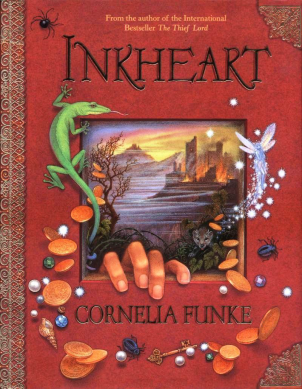
This project promotes open access materials and has been funded with support from the European Commission - Erasmus+ program. These materials reflect the views only of the author, and the Commission cannot be held responsible for any use which may be made of the information contained therein.
[Project Number: 2016-1-HR01-KA201-022159]
![]()
Book title
The book thief
Author
Markus Zusak

Bibliographic information
Publisher: Black Swan
ISBN: 9780552779739
Links (adaptations, reviews, full texts etc.)
- https://www.goodreads.com/book/show/19063.The_Book_Thief
- https://www.amazon.com/Book-Thief-Markus-Zusak/dp/0375842209
Theme
A book about struggles of ordinary people during the World War II
Short summary
During World War II Germany, young Liesel finds comfort in stealing books and sharing them with others. In the basement of her home, a Jewish refugee is being protected by her adoptive parents. When her stepfather finds out that she cannot read he decides to teach her, although he is not a good reader himself. Liesel is so eager to read books that she decides to save one from a bonfire made by German Nazi.
Why is the story appropriate for the targeted groups of RSP readers?
- It reflects readers´ interests
- The recommendation and the report emerged from the survey results
- It reflects political/historical moment.
- It’s highly motivational
- It promotes understanding of cultural diversities and heritage
What are the distinguished readers interests reflected by this book/story?
-
Why is this story motivational for the pupils?
The story describes the power books can have, even in difficult life situations, it also depicts the hard life of people in the World War II and the importance of solidarity of people living in certain communities regardless of their nationality, social class or status.
Is there a historical, political, multi/inter cultural, migrant or similar context recognized in this book/story?
Yes - Liesel´s stepparents try to help a Jewish refugee. It describes the cruelty of the World War II.
Is there a principle of inclusion reflected in this book/story and does it promotes understanding of cultural diversities and heritage?
Students can learn the importance of family, community and friendship.
Title of Activity
Puzzle
Description of educational activity
Duration: 90 minutes
Pupils’ age: 15-19
Organization of the class of pupils: group work
The aim of the lesson:
The aim of the activity is to develop reading literacy of pupils, to support their reading skills, to use their competencies to analyse the source text, to compare the present based on their experience and the future based on the text, to reinforce their language skills when verbalizing the results of their work. To analyse the text, to generalize, express insight, or respond by connecting to other texts or situations.
Support materials:
- Puzzle – with some illustrations from the extract and with the text.
- A short story – Mona (one page from the novel). Each student is given a copy of it.
Activities:
Before reading questions: The teachers have some motivational questions: e.g.: What do they think how the computers will affect our future lives. What will be the positive and negative impacts in the future? How far could technology go in revolutionizing our lives?
- Warm up activity (competition) – students work in groups. Each group is given a puzzle with the text which we want them to read and on the puzzle are some illustrations from the excerpt. Their task is to find solve the puzzle, to get the whole text.
- After the puzzle is solved the students give hints about the text. It is important not to read the whole text immediately after solving it. The students try to guess what the story is about.
- The texts are handed out. The students read the short story. Or they can read it from the puzzle.
-
The students log in to the https://kahoot.it/
-
The teachers log in to the https://create.kahoot.it/login
-
Click the “Find kahoot” and find there “Mona Puzzle” (you can add to the filter that it is in English language and it is a quiz for schools). There is a multiple choice activity with comprehension questions about the text.
- The students discuss the story which shows us how the future of the computers can influence us. They can express what they think about the future.
- They make their predictions about the story in groups.
- The students will present the results of their work.
Connection to curriculum
Grade: 3rd grade of bilingual studies
Bilingual curriculum: The study of literature is focused during the third year on reading comprehension of literary texts which are based on the interests of the students which involves sci-fi, too. The aim of the curriculum is to teach students to work with the text, to analyse the texts. Understanding texts, weighing their merits, and utilizing the information they offer are skills that teenagers draw on throughout the curriculum.
Knowledge:
- Summarize
- Develop reading fluency
- Improve reading comprehension
- Recognize main idea and supporting details
Skills:
- Preview and predict
- Use prior knowledge
- Use decoding and vocabulary strategies
- Competences:
- Make connections between fiction and real life or personal experiences
- Be able to visualise material read
- Follow specific instructions and conventions
Competences:
- Make connections between fiction and real life or personal experiences
- Be able to visualise material read
- Follow specific instructions and conventions
Bibliographic reference to be used during the activity
Mona
Dan T. Sehlberg
Brunswick, Victoria Scribe Publications, 2014.
ISBN13: 9781922070975
441 pages

Digital sources
Results
The expected outcomes of the lesson are:
- The students will be able to understand the text and to compare the technology nowadays with the technology in the future.
- They make predictions.
- To offer observations, make connections, speculate, interpret, and raise questions in response to the text.
Recommendations
Both the teaching method and the text can help in increasing students’ interest in reading. This text describes the possible future of the technology and how the computers can influence our life both in negative and positive ways. It can help students to discuss its positives and negatives.
The teacher monitors the students so as to make sure they cooperate effectively.
Book title
Mona
Author
Dan T. Sehlberg

Bibliographic information
Publisher: Spiderline
ISBN 1770893938
Links (adaptations, reviews, full texts etc.)
Theme
A story of a man who tries to save his wife’s life. He shows commitment, love and bravery.
Short summary
Eric Söderqvist, professor at the Royal Institute of Technology in Stockholm, has invented Mind Surf: a thought-controlled system that allows people to browse the web. Samir Mustaf is a former MIT professor whose daughter Mona was killed by a bomb five years earlier. He has just developed the most sophisticated computer virus the world has ever seen, for the purpose of a cyber-attack against Israel’s financial system. Samir Mustaf is a former MIT professor whose daughter Mona was killed by an Israeli cluster bomb five years earlier. He has just developed the most sophisticated computer virus the world has ever seen, for the purpose of a cyber-attack against Israel’s financial system. Eric’s wife Hanna falls into a coma — struck by an aggressive and previously unknown virus — after having tested her husband’s invention. The doctors are at a loss. Although everyone around him thinks he’s gone mad, Eric is convinced that his wife has been infected by a powerful computer virus known as Mona, and that the only way he can save her is by tracking down its creator.
Why is the story appropriate for the targeted groups of RSP readers?
- It reflects readers´ interests
- It’s highly motivational
- It reflects political/historical moment
- Recommendations and the report emerged from the survey results
- Refers to actual migrant situation
- It promotes understanding of cultural diversities and heritage
What are the distinguished readers interests reflected by this book/story?
-
Why is this story motivational for the pupils?
The story describes how technologies can be linked to our brains and what damage it might cause and thus warns us against misusing it.
Is there a historical, political, multi/inter cultural, migrant or similar context recognized in this book/story?
Yes - It describes the conflict between Israel and Lebanon and its consequences on common people.
Is there a principle of inclusion reflected in this book/story and does it promotes understanding of cultural diversities and heritage?
The importance of the cultural and religious belonging.
Title of Activity
Pantomime a story
Description of educational activity
Duration: 130 minutes
Pupils’ age: 15-19
Organization of the class of pupils: group work
The aim of the lesson: The aim of the lesson is to improve the reading literacy of the students. To improve their reading comprehension and to be able to find those ideas of the excerpts which will help them to mime their part of the excerpt so that they can put together the storyline.
Students will gain knowledge and understanding of identifying supporting details and examples in non-fiction, fantasy text.
Support materials:
Excerpt cut into five parts. Anything students can find to help them mime their part.
Excerpts from the book Inkheart: Chapter 56 The Shadow.
- Part 1: page 271 (In books hatred.......).....page 272 ( - and Meggie´s reading.)
- part 2: page 272 (Meggie felt...) ...page 273 ( ...the ticking)
- part 3: page 273 (A very fine speech… - Meggie obeyed.)
- part 4: page 273 (Hastily… )....page 274 ( ...fear.)
- part 5: page 274 (Meggie bent over the book … page 275 (.... in the wind)
Activities:
- The students are divided into groups of 4-5.
- Each group gets a part of the excerpt.
- The students have to read their part.
- Then each group works separately in a different classroom or any room where they practise miming their part of the excerpt.
- After practising members of each group mime their part.
- After seeing all groups students discuss what happened in each performance and try to put the storyline in the correct order.
- They have to justify their decision.
- Discussion: The students are enabled to interact, to discuss within the group, to argue for or against an opinion.
Evaluation and assessment method:
- Throughout the lesson, ensure that your students are backing up their choices with accurate supporting details.
- Teacher's observations of student preparedness, student work samples, and participation in group activities.
Effect of the activity on RSP reading: Practices that support students´ choice, collaboration, and shared control of learning outcomes can be linked to self-expressed interest in reading and engaged reading behaviours.Teachers can organize reading instruction to develop self-efficiency, competence, and engagement in teenage students.
Connection to curriculum
Grade: 2nd grade of bilingual studies
Bilingual curriculum: the study of literature is focused during the second year on reading comprehension of literary texts which are based on the interests of the students which involves fantasy, too. The aim of the curriculum is to teach students to work with the text, to analyse the texts. Understanding texts, weighing their merits, and utilizing the information they offer are skills that teenagers draw on throughout the curriculum.
Knowledge:
- Develop reading fluency
- Improve reading comprehension
- Organise information in a specific way
Skills:
- Use performing skills
- Distinguish reality and fantasy
- Make predictions
- Compare and contrast
- Summarize
- Work effectively in groups, respecting others
Competences:
- Make connections between fiction and real life or personal experiences
- Be able to visualise material read
- Follow specific instructions and conventions
- Evaluate evidence
- Support and justify an opinion
Bibliographic reference to be used during the activity
Cornelia Funke
Inkheart
Publisher: Chicken House Scholastic Inc.
ISBN: 9780439709101
Page count: 534
Year of issue: 2007

Results
The expected outcomes of the lesson are:
- The students will be able to understand the important parts of the excerpt which they will demonstrate by miming and subsequently to work out the storyline
- To connect ideas and themes across texts.
- To offer observations, make connections, speculate, interpret, and raise questions in response to the excerpts.
Recommendations
Both the teaching method and the text can help in increasing students’ interest in reading. This text promotes love towards books which can encourage students to read more. The teacher monitors the students so as to make sure they cooperate effectively.
The volume of given fragments of books can be adapted to the
potential of a group - fragments can be shorter - by cutting less important paragraphs, or be expanded to additional fragments of the same novel.
Contact
X gimnazija ''Ivan Supek''
Ul. Vjekoslava Klaića 7
10000
Zagreb
E-mail: partners@handbook4rspreaders.org










